- Italy Tours Home
- Italy Ethos
- Tours 2023
- Blog
- Contact Us
- Dolomites
- Top 10 Dolomites
- Veneto
- Dolomites Geology
- Dolomiti Bellunesi
- Cortina
- Cadore
- Belluno
- Cansiglio
- Carso
- Carnia
- Sauris
- Friuli
- Trentino
- Ethnographic Museums
- Monte Baldo
- South Tyrol
- Alta Pusteria
- Dobbiaco
- Emilia-Romagna
- Aosta Valley
- Cinque Terre
- Portofino
- Northern Apennines
- Southern Apennines
- Italian Botanical Gardens
- Padua Botanical Garden
- Orchids of Italy
Auronzo and Misurina: Tranquil Lakes and Ancient Woodlands in Majestic Dolomite Setting.
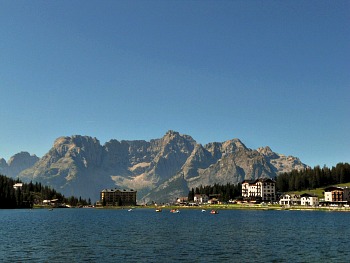
Auronzo is one of the most important resorts in the province of Belluno, and one of the main centres of Cadore.
Part of its municipality – which is fairly extensive – comprises also the magnificent setting of Misurina lake, in whose tranquil water are reflected some of the Dolomites’ giants – such as the famous view of the Sorapiss pictured above.
The town itself lies elongated for about 5 km along the shores of an artificial lake (Lago di Santa Caterina a.k.a. di Auronzo), which was originally created in 1930-32 for hydro-electric purposes (energy production) and that has significantly helped to boost the touristic fortunes of the town ever since.
The lake is now widely used for water sports competitions that have gained a reputation at national level.
Auronzo is also one of the most representative examples of a town almost entirely rebuilt at the time of the ‘Rifabbrico’ movement (1859-63), and it certainly stands as one of its most ambitious achievements.
The design here foresaw the development of a linear town, with the two main nuclei of Villagrande (now the centre of Auronzo) and Villapiccola connected by a wide, urban-looking thoroughfare.
The design remained incomplete, but it is still recognizable today, here and there, in the familiar grid of roads that cross neatly at 90°, and in the regular housing, with the typical three- or four-storey residential buildings, most of them painted white with multi-coloured shutters.
The focus was hygiene, cleanliness and order, as the main goal of the ‘Rifabbrico’ was that of safely rebuilding in stone old wooden villages that not only were prone to fires but also – in some cases at least, as indeed in Auronzo – overcrowded, and offering poor living conditions.
Today we may take for granted how these villages look, but at the time the contrast between the old and the new could not have been greater: in short, the ‘Rifabbrico’ was a statement of the new; of urban ideals of social and architectural reformation finally making it into the mountains.
Perhaps the grandest achievement of the ‘Rifabbrico’ movement – not only in Auronzo, but within the whole of Cadore – was a building that can still be admired here: the church of San Lucano in Villapiccola (1850-56).
As you enter Auronzo from the south – past the dam that originates the lake, and the gothic chapel of Santa Caterina that gives the lake its name – there couldn’t be a starker sight than to see this massive, octagonal building at the end of a straight stretch of road.
Towering with its candid mass and imposing bell-tower – visible from a great distance, and undoubtedly the main landmark in Auronzo – this disproportionate, yet grand church makes the town instantly recognizable when viewed from above.
The church of San Lucano is in itself a statement of all the goals of ‘Rifabbrico’ and of its time: its white surfaces stand for cleanliness and the Greek ideals of harmony alike, within a purely Neo-classical frame.
The architect was Giovanni Segusini – a familiar name in Cadore at the time, as he was responsible for planning and erecting most of the new churches during the ‘Rifabbrico’ wave of rebuilding.
He was an academic from Venice who clearly looked at the classical ideals of ancient Greece for inspiration, but found it also in the purity of design of a noble predecessor, Andrea Palladio – and all of these influences are clearly detectable here, coming together in this imposing yet harmonious building.
The centre of Auronzo documents quite well also its development as an historical tourist resort, with old hotels and villas that range in a variety of styles, from liberty to rationalism. The town hall was planned by Edoardo Gellner – a famous 20th century architect from Cortina – in 1972-78.
Surely enough, though, Auronzo is best known for the wide expanses of nature and celebrated mountains that surround its territory. Indeed, comprised within its municipality – one of the widest in Italy for its extension – are some of the Dolomites’ most famous peaks.
Some of the Most Celebrated Dolomites Are Here!
One can start with Monte Agudo (1,573 m): the 'natural' point of interest closest to the centre of town, which – as the name suggests (“Mount Acute”) – is a pointed peak easily reachable from just outside Auronzo with a chairlift.
The mountain top has a few ski slopes, and provides excellent views over the town and surrounding mountains, such as Monte Aiàrnola (2,456 m) and Croda dei Toni (3,094 m).
This location also allows the more adventurous walker to connect with paths in altitude, which lead towards the craggy peaks of the Marmarole (2,932 m), with the further possibility of descending either to Lozzo via Pian dei Buoi or to Calalzo through the Val d’Oten.
But the most enticing prospects for the nature-lover and for walking alike lie further afield, and one only has to ascend the solitary Valle dell’Ansiei to reach them.
This valley is very sparsely populated, with hamlets that usually present some interesting examples of vernacular architecture – such as Cosderuòibe and Palùs San Marco – but most of the area is inhabited only seasonally, as its extensive pastures were traditionally used for animal grazing during the summer.
With farming activities dwindling, though, many of the old buildings have now either been abandoned or reconverted into B&Bs or farms offering accommodation – and these can be very good alternatives if you want to avoid Auronzo altogether, and be closer to the mountains.
In ancient times this used to be also a mining district; lead and zinc were excavated in the massive complex of the Argentiera (now disused) – and the ruins can still be seen along the main road.
Around the upper Ansiei valley, however, is where things get really interesting: one of the Dolomites’ foremost paradises begins – and the celebrated peaks of the Sorapiss (3,205 m) and Cristallo (3,221 m) are the first colossal mountains to come into sight (below, a view of the Sorapiss from Lago Antorno, near Misurina).
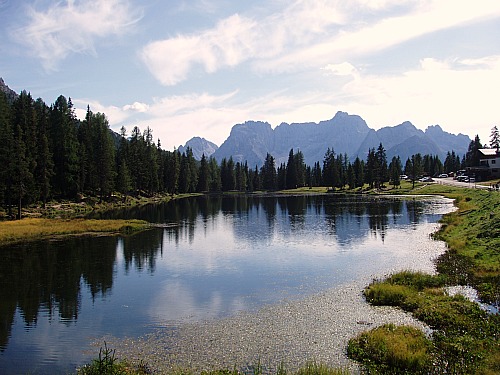
Further on, the magnificent Tre Cime di Lavaredo/Drei Zinnen (2,999 m) appear almost like a magical vision.
All these splendid peaks are within reach – but these mountains will require strenuous walking, unless you make use of the chairlift to Col de Varda (2,115 m; from the southern end of Misurina lake) or of the toll road to the Tre Cime (neither of which options are advised if you don’t love crowds).
There are quieter spots, though: for example, if you head into the wide expanse of the Somadida forest – a nature reserve that will allow for solitary treks among columnar firs and spruces.
In the old times, this was one of the woodlands that Venice used for supplying its naval fleet with oars, while paths leading further in altitude will take you towards the upper reaches of Sorapiss (with the possibility of connecting forward to San Vito – but this option is recommended to experienced walkers only).
Other options for trekking include the Val Marzòn – a narrow gorge which opens straight on to a famous view of the Tre Cime di Lavaredo/Drei Zinnen at the end. You can rest assured that you won't find overcrowding along its paths, but at the same time the celebrated peaks will certainly have to be hard-earned from here!
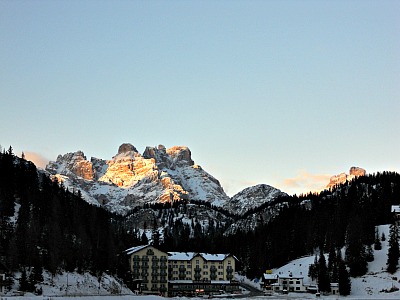
Misurina Lake: an Absolute Must-See in the Dolomites.
Further up the valley is one of the ‘hotspots’ of the whole Dolomites region: the Lake of Misurina (Lago di Misurina). Nestled among Dolomite giants at 1,735 m above sea level, Misurina lake deserves by all means a stop, but the shores adjacent to the National Road are basically a tourist playground – so you’d better avoid them!
If you want to savour the beauty of the place, it is best to head past the Col de Varda chairlift station (that takes up to Rifugio Col de Varda, 2,106 m), and walk on to the other side of the lake, where the reflections of the surrounding mountains – and the dramatic skies – are usually at their most stunning (see picture below).
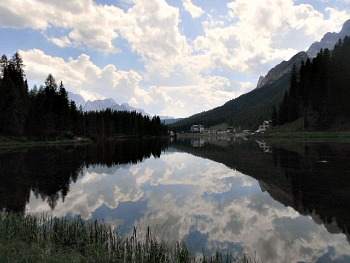
The views on the Sorapiss from here (see picture below) and the Tre Cime di Lavaredo/Drei Zinnen are among the Dolomites' most famous – and quite rightly so: it may not be a quiet spot (but in fact, off season, it often is), but it certainly is a must-stop for the mountain lover.
Immersed in a setting of majestic conifer woodland and with historical grazing lands opening up nearby, the lake is surrounded on all sides by renowned Dolomite giants such as Monte Sorapiss (3,205 m), Cristallo (3,221 m) and the Cadini di Misurina (2,839 m).
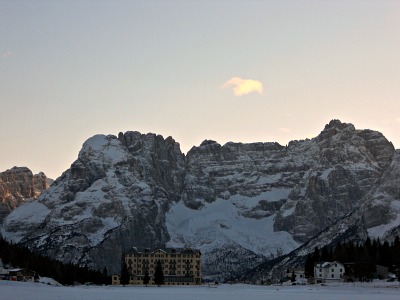
Not far from here is also the beginning of the toll road that leads up to Rifugio Auronzo (2,320 m) and the Tre Cime di Lavaredo/Drei Zinnen (below, looking towards the Tre Cime from the pastures along Lago Antorno, at the beginning of the toll road).
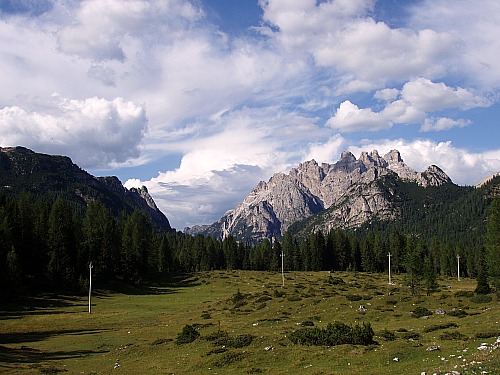
All in all, the area around Misurina lake is, on the whole, hugely frequented, but it is worth stressing that there is so much nature around it that if you care to avoid certain specific spots (such as the ones mentioned above) – and the high season – it is not difficult to find peace and quiet here too, and be rewarded with a still relatively wild nature as well as unforgettable views.
In the final picture below is shown the wetland area situated at the top end of Misurina lake, where there is an interesting colony of hygrophilous (water-loving) plants as well as prolific populations of Lupin (Lupinus sp.), flowering profusely every year.
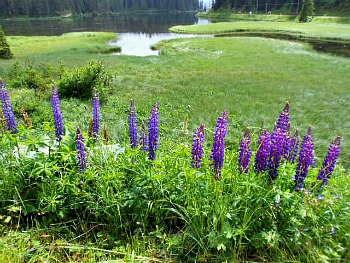
Return from Auronzo to Italy-Tours-in-Nature
Copyright © 2010 Italy-Tours-in-Nature

New! Comments
Have your say about what you just read! Leave me a comment in the box below.